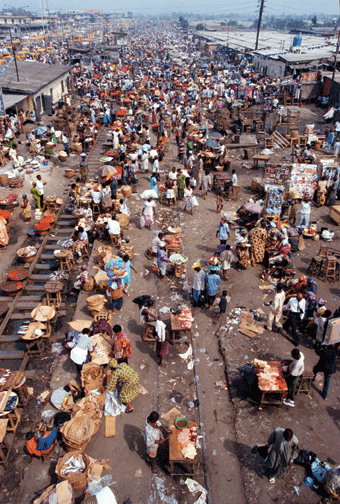
![]() Cities
Cities
Half 0f Humanity Will Live in Cities by Year’s End
Humans are about to become a majority urban species for the first time. Does this trend mean poverty or prosperity for the world’s urban dwellers?
By: Brian Handwerk *
 A U.N. forecast reports that half of all humans will live in urban areas by the end of the year and 70 percent by 2050 even though cities occupy only about 3 percent of Earth’s land surface.
A U.N. forecast reports that half of all humans will live in urban areas by the end of the year and 70 percent by 2050 even though cities occupy only about 3 percent of Earth’s land surface.
Urban growth is driven by the developing world, where African and Asian cities grow by a million people a week, according to the U.N. Population Fund (UNFPA) report.
Cities are growing, in part, because their large, young populations are in their reproductive prime. But observers note that much urban growth also stems from steady migrations of rural dwellers looking for economic opportunity.
Surging cities in economically challenged nations can present a host of problems.
About a billion people currently live in sprawling city slums with inadequate access to clean water, proper sanitation, or legitimate housing, the report states. That number could double in three decades.
But some experts, including the report’s lead author, say urbanization provides valuable economic opportunities.
The historically wealthy nations in Europe and North America, for example, are more than 70 percent urbanized.
“Contrary to what most policy makers have been saying, urban growth can be extremely positive for economic growth, social development, demographic stabilization and even for environmental issues,” says George Martine, a demographer who wrote the UNFPA’s recent State of World Population 2007 report. “But in order for that to happen, we’ll need to take a completely different approach from the one that people are taking now.”
Martine notes that cities generate most of the world’s income from goods and services.
“So to try to prevent urban growth is like shooting yourself in the foot from an economic standpoint,” he says. “If you have better chances for economic growth, this also has implications for social development -- you need resources to provide social services.
“Education, health care, any type of social service costs less in cities per capita than it does in rural areas.”
Unfortunately, many cities are failing to provide such services to their quickly growing populations, observers say.
David Satterthwaite, a senior fellow with the International Institute for Environment and Development in London, says the blame falls squarely on governments.
“I get annoyed by people looking at urbanization negatively. What we should look at negatively is the incompetence of governments to actually manage it,” he says.
Much urban growth is unregulated because some authorities don’t want to encourage the trend toward urbanization, Martine added.
“They would like urbanization to stop because they see it concentrating poverty,” he says. “It’s a very visible and negative manifestation in terms of politics.”
By 2050, there may be as many as 27 megacities cities with populations of ten million or more up from 19 megacities today. But such huge centers won’t represent most urban growth, experts say.
Instead, global urbanization will largely occur in smaller cities that are part of broader, growing urban areas, they note.
“In general as cities get very large, you get a pattern of a very urbanized region, but a lot of production is decentralized,” Satterthwaite says.
He notes that many big cities, like Buenos Aires, Argentina; Rio de Janeiro, Brazil; and Kolkata (Calcutta), India, actually have more people moving out than coming in.
Smaller cities may offer the chance at better governance and thus greater success because their developing governments are more transparent, while some big cities have already become too cumbersome, according to Kamla Gupta of the International Institute for Population Sciences in Mumbai (Bombay).
“There is a need to limit the physical and population size of cities that have expanded too much ... and have achieved inordinately large population size,” she says. “It is extremely difficult to manage overgrown cities, in spite of huge investments.”
Geographer Nigel Thrift, vice chancellor of the U.K’s University of Warwick, stresses that the urbanization trend is anything but homogenous across the globe.
“You shouldn’t infer that the same solutions would work in different parts of the world,” he says. “There are many Asian cities where, though there are many people living in difficult circumstances, the figures on economic growth suggest that it may be possible to do something about it. In other cities that’s not the case.”
He suggests that a kind of global Marshall Plan, the economic aid package that helped rebuild postwar Europe, could be implemented to address the needs of growing cities. Such aid would need to be flexible to accommodate the unique needs of different locales, he says.
“(In) cities with more potential, what you’re doing there is investing in growth,” he says. “With the others, that’s not enough.”
In those most desperate cities, according to Martine, the author of the U.N. report, turning urban growth into a positive begins with planning for decent housing.
“What really determines whether or not people are going to have access to what the city has to offer is to have a home, an address, a place they can keep their stuff, lock the door, or set up a little business,” he says. “It may be precarious at the beginning, but it’s really the starting point for accessing what the city has to offer.”
* Brian Handwerk is a regular contributor to National Geographic News.